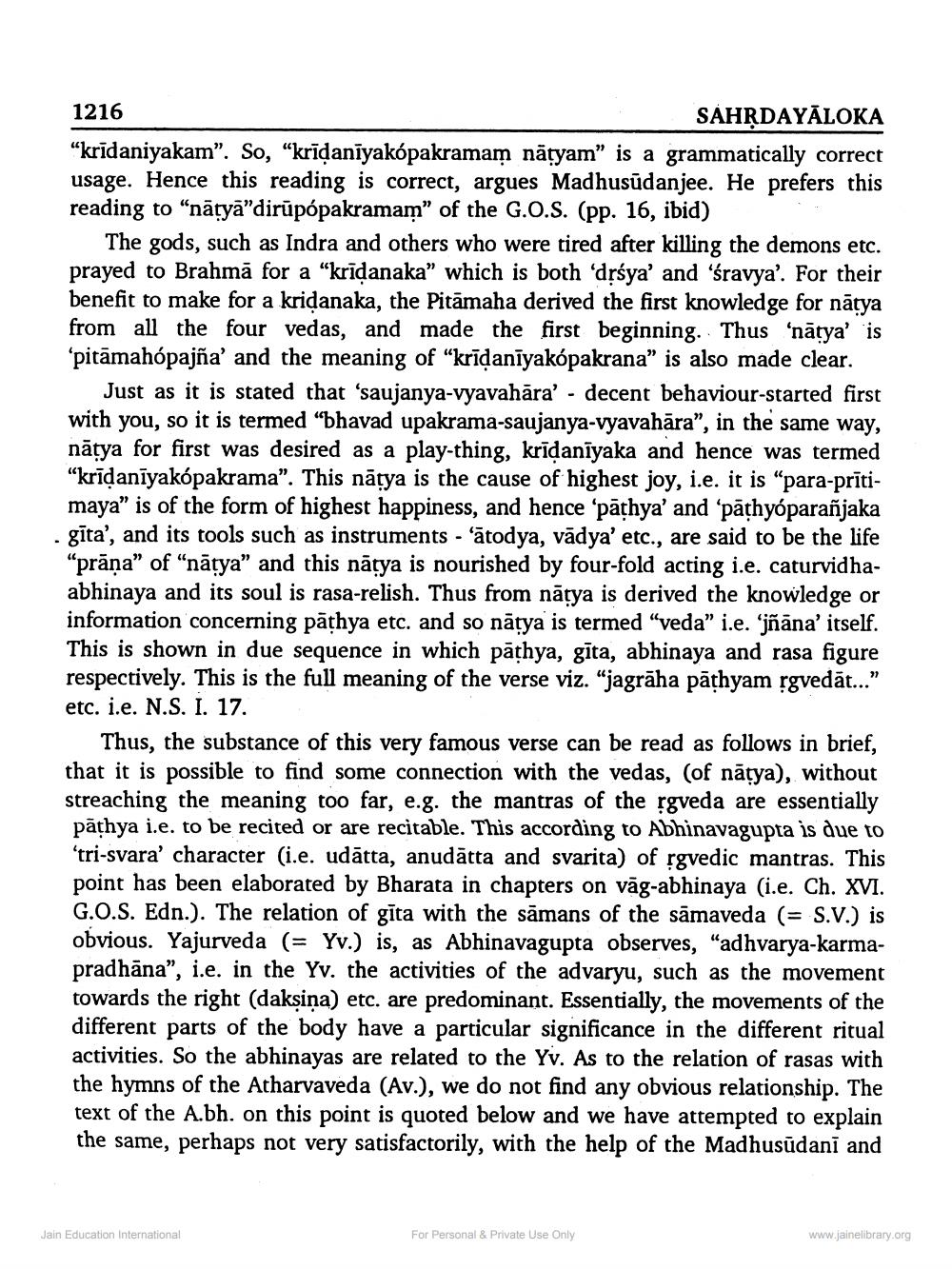________________
1216
SAHRDAYĀLOKA “krīdaniyakam”. So, “krīdanīyakópakramam nātyam” is a grammatically correct usage. Hence this reading is correct, argues Madhusūdanjee. He prefers this reading to "nāryā”dirūpópakramam" of the G.O.S. (pp. 16, ibid)
The gods, such as Indra and others who were tired after killing the demons etc. prayed to Brahmā for a “krīdanaka” which is both 'drśya' and 'śravya’ For their benefit to make for a kridanaka, the Pitamaha derived the first knowledge for nātya from all the four vedas, and made the first beginning. Thus 'nātya' is 'pitāmahópajña' and the meaning of “krīdanīyakópakrana” is also made clear.
Just as it is stated that 'saujanya-vyavahāra' - decent behaviour-started first with you, so it is termed "bhavad upakrama-saujanya-vyavahāra”, in the same way, nātya for first was desired as a play-thing, kridanīyaka and hence was termed "krīdanīyakópakrama”. This nātya is the cause of highest joy, i.e. it is “para-prītimaya” is of the form of highest happiness, and hence 'pāthya' and 'pāthyóparañjaka . gita', and its tools such as instruments - 'ātodya, vādya' etc., are said to be the life "prāņa” of “nātya” and this nātya is nourished by four-fold acting i.e. caturvidhaabhinaya and its soul is rasa-relish. Thus from nātya is derived the knowledge or information concerning pāthya etc. and so nātya is termed "veda” i.e. 'jñāna' itself. This is shown in due sequence in which păthya, gīta, abhinaya and rasa figure respectively. This is the full meaning of the verse viz. “jagrāha pāțhyam rgvedāt...” etc. i.e. N.S. I. 17.
Thus, the substance of this very famous verse can be read as follows in brief, that it is possible to find some connection with the vedas, (of nātya), without streaching the meaning too far, e.g. the mantras of the rgveda are essentially pathya i.e. to be recited or are recitable. This according to Abhinavagupta is due to 'tri-svara' character (i.e. udātta, anudātta and svarita) of rgvedic mantras. This point has been elaborated by Bharata in chapters on vāg-abhinaya (i.e. Ch. XVI. G.O.S. Edn.). The relation of gīta with the sāmans of the samaveda (= S.V.) is obvious. Yajurveda (= Yv.) is, as Abhinavagupta observes, "adhvarya-karmapradhāna”, i.e. in the Yv. the activities of the advaryu, such as the movement towards the right (daksina) etc. are predominant. Essentially, the movements of the different parts of the body have a particular significance in the different ritual activities. So the abhinayas are related to the Yv. As to the relation of rasas with the hymns of the Atharvaveda (Av.), we do not find any obvious relationship. The text of the A.bh. on this point is quoted below and we have attempted to explain the same, perhaps not very satisfactorily, with the help of the Madhusudani and
Jain Education International
For Personal & Private Use Only
www.jainelibrary.org




